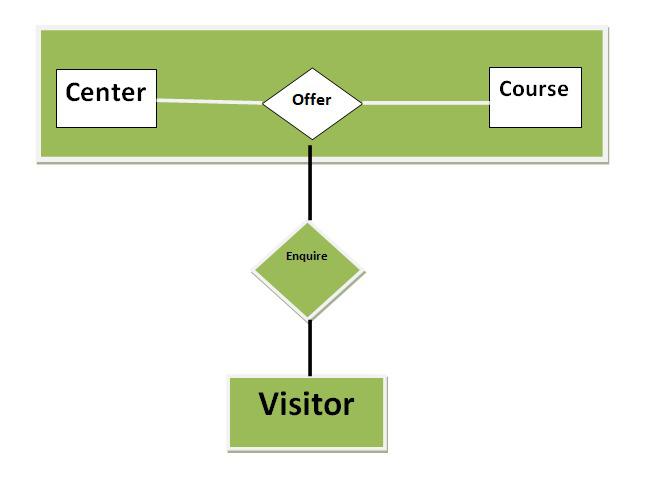Aggregation in DBMS
Last Updated :
28 Feb, 2024
In Database Management Systems (DBMS), aggregation is like mathematically setting collectively a jigsaw puzzle of health. It’s about placing all of the pieces together to create an entire photograph. In this article, we are going to discuss What is aggregation in a Database, its applications, etc.
What is Aggregation in DBMS?
Imagine constructing something with Lego blocks. Each piece by itself doesn’t necessarily suggest it’s a very good thing, but whilst you position it together, you can create something extraordinary. That’s what aggregation in a DBMS is about – connecting man or woman facts factors to give meaningful insights. Whether we add up numbers or see styles in complicated relationships, connecting them makes it less difficult for us to experience statistics. Similar to constructing with Legos, there are numerous approaches to gathering statistics in a database.
Aggregation is a concept wherein the connection between two entities is considered as one unified entity. It includes combining the relationships with their respective entities into a better-degree entity.
When it comes to statistical information in a DBMS, there are extraordinary gears and approaches to collect it, too:
- SUM: It is used for adding things up.
- AVG: It is used for finding the middle ground.
- Minimum (MIN): It is used to get the singling out of the smallest values.
- Maximum (MAX): It is used for singling out for the largest values.
- COUNT: It is used for a headcount and DISTINCT for counting unique items.
- Filtering Aggregated Data: Picture sifting through a treasure trove to find the real gems: We use the HAVING clause to filter out the noise and focus on the valuable insights.
Examples of Aggregation
Here is a scenario that represents the diagrammatic representations of the Aggregation in the Database Management System.

Aggregation In Databases
Here is the scenario, Imagine an education center supplying diverse guides. Here, the training center and the courses it gives are handled as a single entity within the dating, that’s then connected to any other entity, inclusive of a visitor. In realistic terms, while a traveler interacts with the coaching center, they usually inquire about both the publications supplied and the middle itself instead of focusing entirely on one component.
When Aggregation in DBMS is Used?
Aggregation proves its usefulness in a DBMS when information stored in a database wishes to be summarized or evaluated. Let’s take a more in-depth take a look at the helpful technique:
- Report technology: Collection abilities are critical for organizing data, and facilitate complete evaluation tailored to particular organizational goals.
- Business intelligence: The benefits of marketing and corporate reporting gear are enormous. Complete datasets are trustworthy and provide precious insights had to make strategic choices.
- Statistical analysis: Integrated skills is an essential a part of the statistical analysis tool. They facilitate the calculation of fundamental concepts which includes hints, differences, and paths which can be crucial for classifying records and detecting traits
- Data Visualization: Creating associated facts using charts and graphs facilitates in knowledge data. This approach empowers stakeholders to generate concrete insights and actionable conclusions.
- Managing redundancy: Aggregation happens whilst databases have redundant resources. By connecting those assets to different well matched devices, in which communique sources are aggregated into a unified lodge-like entity, records governance will become an awful lot greener, growing typical database performance.
Applications of Aggregation in DBMS
1. Information era
- Aggregation makes it simpler to test record a while within the DBMS.
- Create and summarize records to create precise services tailor-made to the precise needs of the corporation.
2. Strength Assessment Questions
- Collection is vital for successful interviews.
- Helps extract treasured insights from facts sets of equal size by means of successfully solving complex queries.
3. Enhancing Data Retrieval Efficiency
- Archiving improves records retrieval overall performance in a DBMS.
- Precomputation and storage of combination values reduces the computation time of query operations, resulting in quicker recovery instances
Conclusion
As we can sum up, aggregation is an important feature of a DBMS, reorganizing immature data into usable shapes. By streamlining file generation, supporting search queries, and improving overall data retrieval performance, integration helps simplify the performance of simple databases The concept of scalable storage is important for database management and development of green queries to meet the needs of many information processing applications.
Frequently Asked Questions on Aggregation – FAQs
How does Association range from Aggregation?
Association delineates the bond among objects that have interaction reciprocally, whereas Aggregation indicates a relationship characterised with the aid of a grouping of unique objects.
Is Aggregation useful in DBMS?
Indeed, Aggregation performs a pivotal role in DBMS, facilitating computations throughout a couple of rows to generate a consolidated value in the database management gadget.
Can you offer a commonplace instance of Aggregation in normal lifestyles?
A top illustration of Aggregation in every day life is clear inside the cellphone numbers stored on our cellular gadgets. These numbers, representing a collection, can be accessed and referenced by using numerous identifiers or labels.
Share your thoughts in the comments
Please Login to comment...